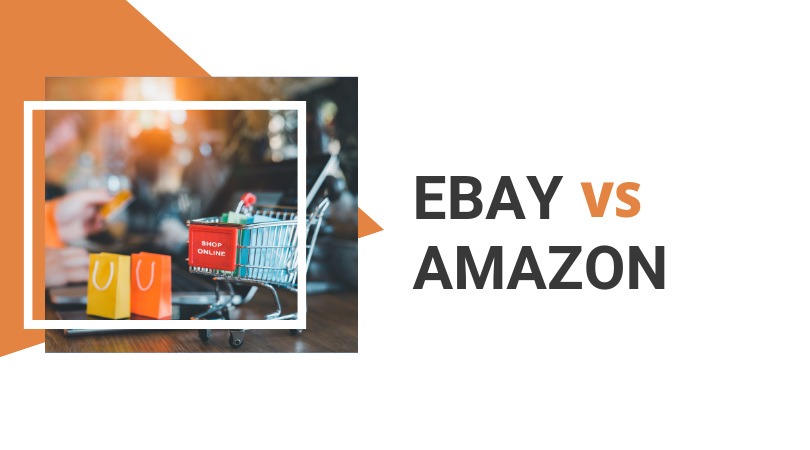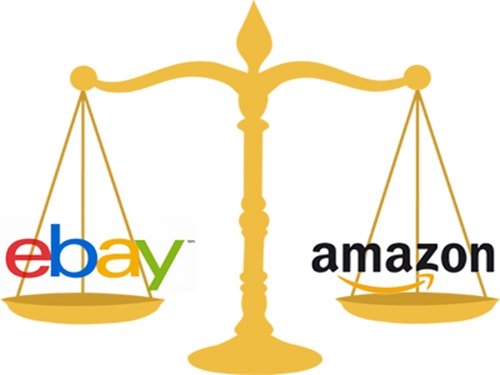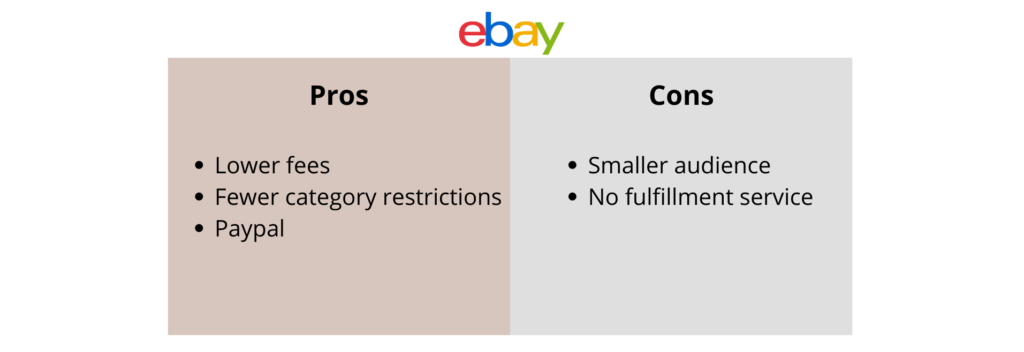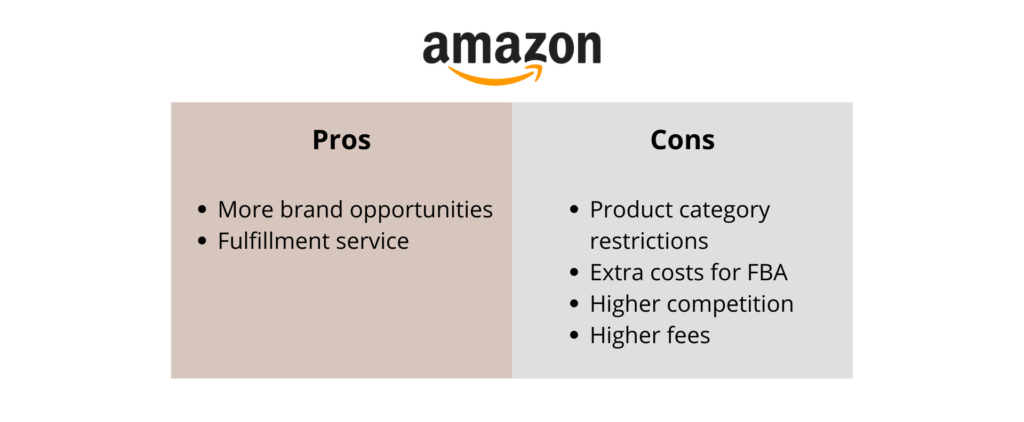If you decide to sell online, you may find yourself facing an important dilemma: Amazon or eBay? Both are among the most well-known marketplaces in Italy and can connect sellers with a vast audience of users. However, there are characteristics that differentiate each platform, which also cater to different target audiences. Here’s what they are, to decide precisely where to sell.
eBay and Amazon: some differences
Amazon is one of the largest marketplaces in the world, where businesses can sell by signing up with two types of accounts based on their monthly sales volume. eBay allows businesses to sell products by registering as a professional seller and additionally with an eBay store.
However, there are substantial differences between the two channels, let’s look at some of them.
|
|
EBAY |
AMAZON |
|
Marketplace type |
Generalist platform |
Generalist platform |
|
Geographic coverage |
24 global sites |
14 global sites |
|
Monthly visits in Italy |
56.8 million |
202.5 million |
|
User intent |
The navigation intent is primarily transactional |
The navigation intent is primarily transactional |
|
Selling format |
On eBay, it is possible to sell both through auctions and by setting a fixed price |
For Amazon, there is no auction, so all products are sold at a fixed price |
|
Photos |
Possibility to customize product photos | Defined product photos |
Auction Format vs. Fixed Price
eBay auctions are the best way to achieve market value for used, vintage, and collectible items, especially when selling unique items. The only exception is for used CDs, DVDs, and books, which sell quite well on Amazon.
Amazon is the king of fixed prices, but eBay has moved strongly in that direction, minimizing auctions and encouraging fixed-price listings.
Are buyers loyal to eBay or Amazon, or do they purchase from both?
The audience of eBay and Amazon is different, as one would expect.
It cannot be denied that both eBay and Amazon have enormous reach, but significantly, each platform reaches a different type of audience!
Both have an international presence.
Amazon has 14 marketplaces worldwide, while eBay has 24 global sites. Both receive a significant number of visitors, including in Italy.
In terms of demographics, Amazon buyers tend to be wealthier. The average Amazon buyer is between 45 and 54 years old, married, has children, and has a college education.
The demographics of eBay consist of 57% male buyers, which may come as a surprise, and 43% female buyers. Among these, the largest group is young buyers between the ages of 35 and 49, comprising 32%. However, these figures mean nothing if you don’t know your own buyer persona!
Determining the buyer persona helps identify if your target audience is already active on these marketplaces and which marketplace they predominantly use.
Interestingly, some buyers are truly loyal to one platform or the other! Some only make purchases on Amazon and would never dream of buying from an eBay seller, while others are staunch eBay supporters and believe that products on Amazon are probably more expensive!
What are the costs for selling on eBay and Amazon?
There are two types of sellers on Amazon: Individual and Pro. Amazon offers different subscription options to cater to the specific needs of each seller.
For sellers who make less than 40 sales per month, there is no monthly fee, but there is a fixed closing fee and a per-item fee of €0.99.
For sellers who have more than 40 monthly sales, there is a monthly subscription fee of €39.00, which includes the per-item fee, and a fixed closing fee.
eBay distinguishes between two categories of sellers: sellers without a store and sellers with a store.
In the first category, there are no monthly fees for those who do not exceed 50 listings. However, there is an insertion fee of €0.35 per item if the maximum threshold is exceeded.
For sellers with a store, there is a monthly subscription fee of €19.95 with a limit of 300 listings. If the limit is exceeded, there is a fee of €0.15 per insertion.
Both marketplaces also offer additional PRO accounts.
What can I sell on eBay and Amazon?
When it comes to available categories on Amazon and eBay, there are some similarities. The most obvious difference is that eBay does not have as many restrictions as Amazon. Out of Amazon’s 40 categories, 23 are unrestricted, while 12 require approval to sell in.
These are known as “gated categories.” The other five categories have some restrictions depending on the type of product, primarily aimed at preventing counterfeit items.
Other categories may be limited based on the season, for example, toys and games during the holiday season, mainly to avoid an influx of lower-quality products.
On eBay, instead of limited categories, there are lists of restricted items. Before deciding which platform to sell on, it is important to check whether the product or its category is limited, prohibited, or protected. However, there is a wide range of potential categories and products to choose from on both platforms.
Payment methods
Amazon sellers are required to use Amazon Payments to accept payment. Amazon collects the payment and deposits it into the seller’s bank account twice a month. They collect and deposit the funds without any additional fees.
eBay sellers can accept PayPal and credit cards if they have their own merchant account.
Amazon sellers do not have to send invoices, payment reminders, or track unpaid items. If Amazon cannot collect the payment, there is no sale, no need to ship, and the item remains listed on the site.
The eBay system simply requires more work, more time, and ultimately costs more to manage as a seller. But the major advantage of PayPal is that you receive the money more quickly.
Logistics and shipping
There are two ways to sell on Amazon – Merchant Fulfilled (you ship the item to the customer, similar to eBay) or FBA (you ship the items to Amazon, and they handle the shipping and customer service).
If you meet certain criteria as a merchant, Amazon offers sellers a “shipping credit” based on the category, dimensions, and weight of the item.
Right of withdrawal, returns, and warranty
Regarding warranty policies, the two platforms behave differently:
- On Amazon, there is the so-called “A-to-Z Guarantee” that protects customers who purchase on the marketplace in case of product defects that make it non-compliant with its use or description, delivery delays, or issues with returns. In such cases, Amazon reimburses the buyer.
- On eBay, if the merchandise is not delivered, is of poor quality, or has defects, and the seller does not refund the payment, eBay does not provide customer protection but advises them to seek resolution through the appropriate legal channels. Only those who have paid with PayPal are entitled to a refund, as PayPal handles such matters (those who pay with credit card or bank transfer are excluded).
Regarding returns and refunds, Amazon has a very customer-friendly policy. Compensation is available for up to 30 days, and if a seller fails to adhere to the platform’s specified deadline, Amazon activates the “A-to-Z Guarantee” and takes responsibility for refunding the returned item. On the other hand, eBay refers the buyer to the individual seller’s terms and conditions of sale.
The Pros and Cons of Selling on eBay
The Pros and Cons of Selling on Amazon
 Who wins, eBay or Amazon?
Who wins, eBay or Amazon?
The answer is: it depends!
There’s no doubt that eBay is the best for some items, while Amazon is the best for others. In general, eBay is more suitable for used and vintage items.
However, the overlap is incredibly large. Most items sold on Amazon will also be sold on eBay, and vice versa. The important thing to remember is that the buyers are different. Many Amazon buyers are very loyal to Amazon and won’t even visit eBay. Some eBay users feel that it would be a shame to shop on Amazon. By selling on both sites, you can potentially get millions of additional eyes on your products.
To learn more about selling on eBay and Amazon (and promoting your products) through a specialized partner, you can contact us here.





 Who wins, eBay or Amazon?
Who wins, eBay or Amazon?